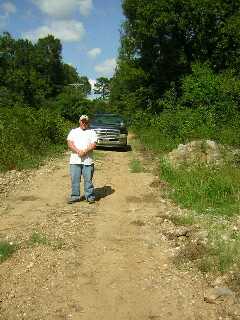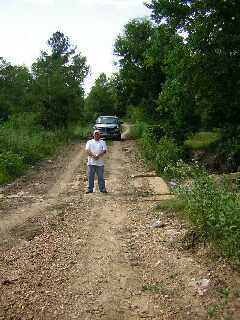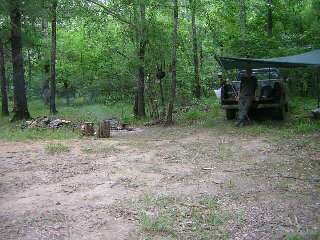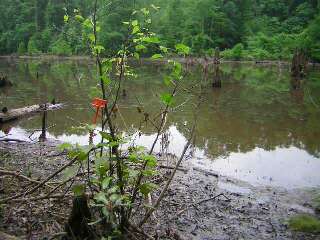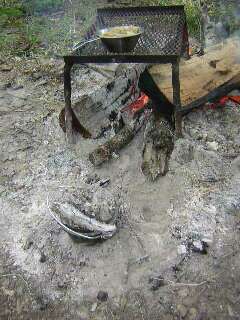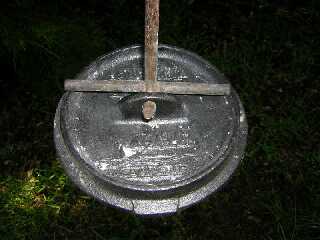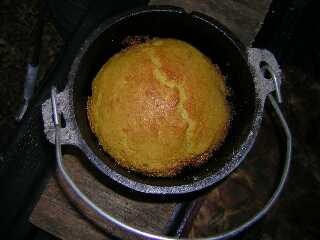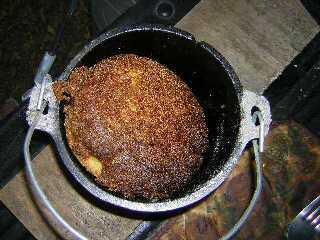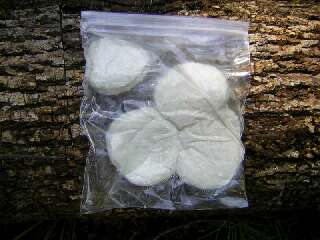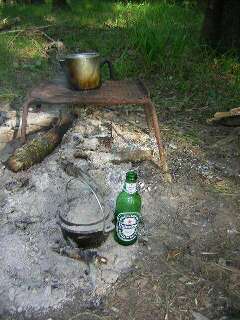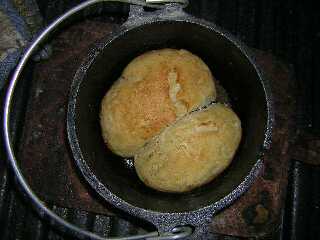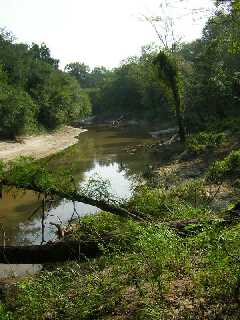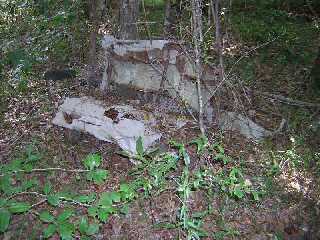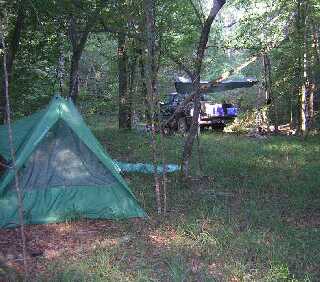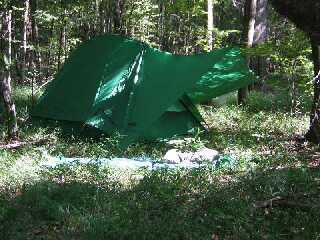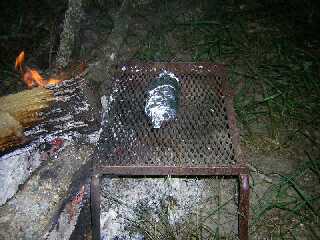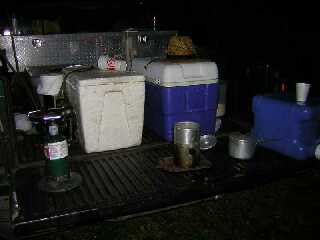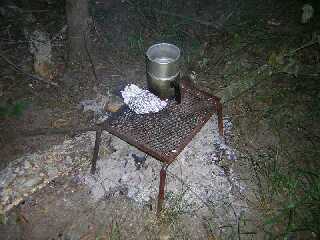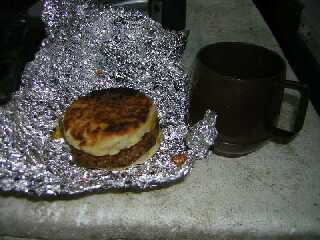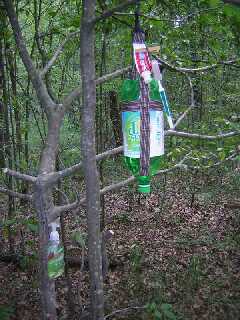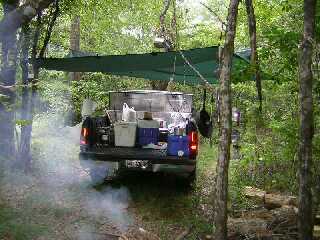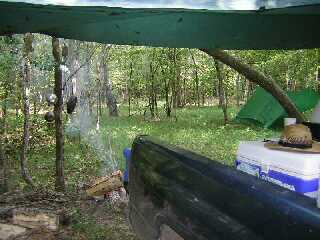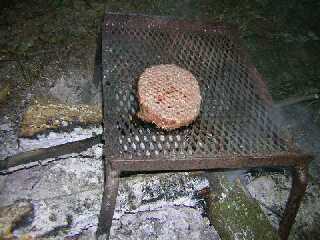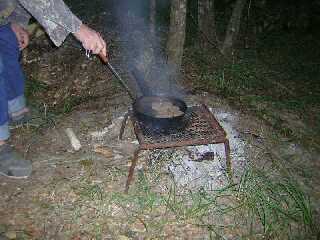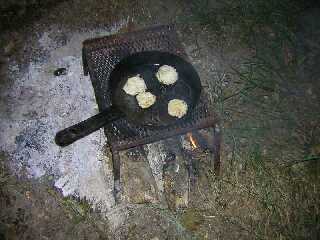Copyright 2009 by Junior Doughty
|
This camping trip didn't start as a five-part, year+ extended excursion—it just happened that way from bad luck. At the beginning I had two goals for the trip:
Let's start with my ratings of some of the store-bought equipment and non-standard food I used on the camping trips. You'll find an explanation for the ratings in the text below. For links to the items, copy the item's exact name as listed in the table and paste it in your Google window.
This food list doesn't include common camping food such as pork ‘n' beans, etc.
My Timberline 4 is the highest quality tent I've ever owned. In addition, you can go online and buy every part of the tent. I'm talking new rain fly, new poles, new shock cord—everything. Mine easily fit back in the bag in which it came! That's a first for me. Mine was a "soiled" return and cost me only $100. I like my Timberline 4 so much, I wish I'd spent circa $400 and bought a Timberline Outfitter 6. The Timberline 4—meaning four person—would be crowded with two people. Some day I'll have female companionship on a camping trip, and I figure the Outfitter 6 would have plenty of room for the both of us and our sleeping gear. Hints:
Trip #1: May 2008Luckily, I took extensive notes during these trips.I arrived at my lakeside campsite circa 1:30 pm and immediately started setting up my new-to-me Timberline 4 tent. Alas, a Chinese engineer had written the instructions in English but in engineer-speak. Three hours later, the tent and the annex were erected. Note: Manufacturers of anything requiring instructions should hire English majors to write those instructions. Next, I blew up my new Therm-A-Rest mattress and put it in the tent. As the weather was warm all I needed was a pillow and a blanket, so I threw them inside with the mattress. Then I crawled inside the tent to try out the new mattress. The 25" wide x 77" long x 1 1/2" thick mattress was plenty soft. However, I'm 73" tall and 20" across the shoulders. The actual working width of the mattress was only 24" so if I lay on my back, my elbows were on the tent floor. If I turned on my side in my preferred semi-fetal sleeping position, either my butt or my knees were on the tent floor. That didn't bode well for comfortable sleep. But my tall body fit ok on the 77" length mattress, so maybe it would sleep ok. Note: my age 66 knees didn't like crawling in and out of the tent. I soon started a campfire and munched on leftover fried chicken. All the while I kept a watchful eye on the lake, rather the level of the lake. It was high because the nearby river was also high and in the lake. But the National Weather Service Internet river gauge had forecast a crest early that day and a steady decline the following days. To my worried eyes late that day, the lake looked like it was still rising. As darkness approached I fixed myself a stiff toddy and leaned back and watched the fire and watched the lake birds close the day. My campfire smoke hung over the narrow oxbow lake like a low cloud drifting in a breeze so soft I could not feel the wind. Oh, I was relaxed and happy. Soon, one stiff toddy became three. Suddenly from far down the lake I heard a sound like a referee blowing his whistle. I actually wondered who the heck would be playing football in the woods across the lake. In near dark, too. Whee whee whee went the whistle, and it soon became a large bird winging down the lake until it passed out of sight and out of sound. Whee whee whee. . . . Filled with whiskey and the beauty of nature, I soon entered the tent and went to sleep. Some fifteen minutes before the crack of dawn, that &^%$#@*(^% bird started screaming whee whee whee from a tree directly behind the tent. I started yelling, but it kept screaming. It wanted me up, so up I got.
Exit from the river bottom was over one of two low water bridges. A low water bridge is simply a low spot in the road with a man-made hard bottom. It's passable during low, high water conditions, if that makes sense. This low water bridge, #1 we call it, became impassable at a river level of 29.5 feet. At a level of 32.0 my campsite was under water. The photo shows my nephew Chad Doughty standing in the low part of the bridge with my pickup behind him. The low part of the bridge is about 2 1/2 feet below road level.
The morning of the screaming bird, the water level across this bridge would have reached Chad's chest. I had seen the river rise 10 feet overnight. If it kept rising, I'd have to let my truck flood at camp and wade or swim out of the river bottom. So I broke camp in a fast hurry. Two days later backwater was over my campsite. It was a close call.
Trip #2: October 2008I arrived at the campsite at 1:30 pm again, and, ignoring the Chinese engineer's convoluted instructions, had the Timberline tent and its annex erected in just over 30 minutes. By 3:35 pm, I had Hormel canned chili warming over the campfire. With the chili, I ate a little bowl of Kraft Easy Mac Macaroni & Cheese. To prepare it, add boiling water to the fill mark of the plastic bowl it comes in, wait about five minutes, then give it a stir and eat. It's easy camp food.Again as darkness approached I watched and listened to the lake birds close the day. Again my campfire smoke hung over the lake like a very low and very slowly moving cloud. Anxious to cast campfire bullets the next morning for the article, I checked equipment. Lo and behold, I'd brought my digital camera but left the tripod at home. Oh, well, it was only 5 miles and 15 minutes to home, so I would just go get the tripod the next morning. I went to bed, hoping the screaming referee bird had migrated to Australia. And I fought the narrow mattress most of the night. It was also too short. If I put the pillow comfortably under my head, my feet hung off the end of the mattress. I woke at daylight. No referee bird called, but up and down the lake hundreds of birds sang in joy of the rising sun. In joy myself, I headed for the coffee makings. Damned if I hadn't left the coffee pot and the coffee at home with the tripod. So home I went, feeling no joy at all. Sitting at my kitchen table and with a cup of electric percolator coffee in my hand, I decided to call and check on my sister. She hadn't been feeling well. Her moaning voice said she was now feeling even worse. Long story short, I hauled her to the ER where they treated her for an infection. I took her home and she went to bed. Now, I had a dilemma. Cell phone reception in the low-lying river bottom varied from iffy to none. If her condition worsened, she might not could contact me. As baby sisters are more important than bullet casting articles, I went back to the river bottom and broke camp.
Trip #3: November 2008This time, I planned an extended trip of maybe two weeks. Hunting season had opened, so I could hunt ol' Mossy Horns in the mornings and work on my article in the afternoons. Winter had also arrived, so I could use my new Wenger +20° sleeping bag. As the forecast called for overnight temps in the low 30s, I should be as warm as toast. Sleep like a baby. Just in case, I brought two blankets.I watched the sun set behind the trees across the lake and listened to the birds again. I could barely hear the far-away rumble of a freight train. Then came the moan of its whistle as it approached a crossing. I suddenly harkened back to my youth and the lonesome sound of a steam whistle on a choo choo train. If I were king of the railroads, I decided, diesel engine whistles would sound like steam engine whistles—all progress isn't good. At exactly 7:03 pm by my notes, I went to bed. And I spent a miserable night. Even with two blankets piled on top on the Menger sleeping bag, I shivered with cold. Circa 3 am I went home. I turned on the propane heater, built a fire in the wood stove, and crawled between the bed covers and slept ‘til almost noon. Then I returned to the river bottom and broke camp again. I would not return, I decided, without a better sleeping bag and mattress. The main problem was the mattress. Too much of me hung over the edges and touched the cold tent floor. In fairness to the mattress and the sleeping bag, I was sick with a Urinary Tract Infection, and I had been sick for so long I didn't know the difference between sick and feeling well. I stayed sick. Unbeknownst to me and to my doctor, a fistula/tunnel had formed between my colon and my bladder. Urine got in my colon and fecal matter got in my bladder. Thus, constant UTIs. I would soon spend months recovering from five weeks in the hospital for a bladder repair and a colon resection.
Trip #4: May 2009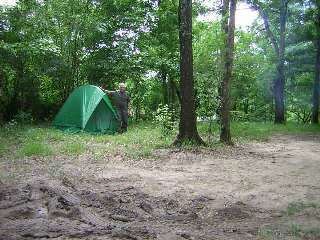 Day #1: It was glorious—the beginning of summer and still cool. I arrived early and set up camp quickly and without a hitch. After so many months of my absence I expected to see my campsite covered in empty beer cans and other trash. It was as clean as could be.
Day #1: It was glorious—the beginning of summer and still cool. I arrived early and set up camp quickly and without a hitch. After so many months of my absence I expected to see my campsite covered in empty beer cans and other trash. It was as clean as could be. Due to the magic of a detailed list, I left nothing at home. Here's the Timberline 4 sans annex, which I decided not to erect this trip. The lake is behind the tent and the campfire is behind and to the right of the camera. Pay particular attention to the mudhole in the left foreground. It's important later. My new Cabela's Ultimate Self-Inflating Sleeping Pad Long was an expensive (~$160) dream of a mattress. At 36" width & 82" length & 3 1/2" thick, I could spread out my elbows and stretch out my legs. I gave it only four stars because it's too thick and too expensive.
Alas, www.sportsmansguide.com seems to have dropped this 10' x 12' tarp from inventory. I gave it five stars because it's heavy duty and has tie-downs galore. It's worth 3x the $19.95 I paid for it.
By late afternoon, my bullets were cast and lubed and sized. I would load them the next morning and be finished with goal #1. Now, I could work on goal #2, which was to catch a catfish. The lake shown here is an oxbow lake and was the river channel circa 1,000 years ago. The river is about 1/2 mile on the other side. Here's one of my six throw lines in the lake. Back in trip #1 high water plagued me. Now low water plagued me as you can see. I caught nary a fish. The bright orange thingy is actually a tent stake. If there's no limb handy I can screw the stake in the ground and secure the line.
The homemade grill belongs to my sister. There's more about it later, including closeups and dimensions. The 12 oz Sierra cup on the grill holds leftover lima beans. Notice how I've straightened the L shaped handle and made it better for campfire cooking. I gave it only three stars because it's only .020" or 25 gauge thick, like almost all camping cookware. Several web sites which sell it say its thickness is 8 gauge or .164". That's way wrong. The handle could be a little longer, too. The manufacturer should wise up and make two versions of this handy dandy cup. This version for backpackers & hikers and a thicker version with a longer handle for those of us who camp from a vehicle of some sort. There's far more vehicle campers than backpack campers! Almost covered in ashes in the foreground, and full of cornbread, is a dandy little Camp Chef 5" Dutch oven. I liked it so much I bought a spare.
The little factory handle is tapered toward the top, and you cannot get a grip on it with pliers. You must either knock off the coals and pick up the lid with gloves or use pliers on the edge to pick it up. Either way sucks, IMHO. The oven still gets five stars from me. I own a drill press so drilling both of my 5" Dutch oven lids was no problem. If you don't have a drill press, take it somewhere that does.
At about the 1 o'clock position of the oven notice a small notch cast into the oven. I guess it's to release steam. As far as I could tell, it had no effect on the oven's bread cooking ability. But food juices soon semi-seal a tight fitting Dutch oven lid and create a pressure cooker effect; thus making the oven perfect for simmering tough food like beans. Camp Chef, take note!
My sister drove out in her little Mercedes Benz, no less, and joined me for dinner. The 12 oz Sierra cup full of leftover lima beans and this pone of cornbread was a perfect meal for two. The meal was so good, one of us surely said, "Wonder how the po' folks live?" When sister left, I baited my catfish lines and then did what I do best—watch and listen to the birds on the lake as the sun goes down behind the trees. Soon, I crawled inside the Timberline tent and went to sleep, at peace with the world. I slept wonderfully on my new Cabelas high-$ mattress. Day #2: The next morning after making coffee and sipping a cup, I walked over to the lake and checked my lines. Nothing. Nada. Zip. Well, there's always tomorrow, I told myself.
Schwans biscuits cook just fine when thawed. As you see in this photo, I slip five of them, frozen, edgeways inside a quart zip bag. They stick together when they thaw, so the trick is not to let them stack, as you see the three on the right have done. Just let the edges touch. Then place the zip bag of biscuits flat in a plastic container inside an ice chest. As an experiment, I left some in a zip bag inside my refrigerator at home. They cooked just fine twelve days later. They're far better tasting than "whop" biscuits, plus you don't have to deal with messy flour and batter at camp if you want "real" biscuits. I gave Schwans #668 biscuits five stars, and they deserve it. Here we see coffee warming in the background and Schwans biscuits cooking in the foreground. The beer bottle is for scale, and I know I should have found something better for scale in a breakfast photo.
Breakfast that morning was these two biscuits with bacon fried in a small skillet atop my one-burner propane stove. I slathered the biscuits with blackberry jelly. It's hard to describe how good that breakfast tasted. It's even harder to describe how glad I was to be at my campsite in the deep woods and alive and healthy again. Well, mostly healthy again. Breakfast finished, I set up my camera on the tripod and loaded campsite ammunition for the article. I then loaded my "Woods Rifle" 30-30 with the campsite ammo, hooked a canteen to my belt, and went for a stroll in the deep woods. I walked the mile to the Paleoindian site I watch and checked it for looter damage. All was well. I returned to camp around noon all tuckered out from walking two miles after so many months of inactivity. Following a peanut butter sandwich and a tall glass of cold milk, I crawled inside the tent and took a nap on top of the high-$ Cabelas mattress I suddenly realized was worth what I paid for it. NOTE: The names and descriptions below have been altered to prevent embarrassment to the guilty. Nap over and me rested, I heard a truck coming through the woods. Up drove a friend herein named Big Boy. Think 200 lb U.S. Marine. He got out and while digging for a beer in the ice chest in the back of his truck, said, "Catchin' any fish?" "Nah," I answered. "I ain't got the first damn bite." "Hell," he said, popping the top of a beer, "I was hoping for a fish fry." "Only fish I got is in a sardine can." We laughed and talked for about one beer each, then heard a truck coming through the woods. Up drove a common friend herein named Small Boy. Think the skinny "before" guy in a Charles Atlas ad. He got out and while digging for a beer in the ice chest in the back of his truck, said, "Catchin' any fish?" "Sardines from a can," Big Boy answered. We drank and talked for about four beers each. One of them dug in his ice chest and came out with nothing. The other one said, "I'm out, too." I said, stupidly: "I've got plenty." Then I nodded at the half gallon of sour mash bourbon on my truck's lowered tailgate and said, stupidly again: "I've got whiskey, too, if y'all want some." They wanted some. I showed them the cups, the mixer, the ice in the ice chest, then said, "Help y'all's self." So they did. Then, so did I. We all three laughed and talked and drank whiskey with lemon-lime soda mixer. Along about the third drink, I noticed that I was the only one using mixer. They were drinking straight whiskey over ice. After a while, I walked over to my truck to mix another drink. From behind me, I heard Small Boy say in anger, "Big Boy, you're a sorry son-of-a-b----!" Not really believing what I had heard, I turned just as Small Boy poked his finger hard into Big Boy's chest and said, "You knew damn well she was my girl!" "Ahhh, Small Boy," Big Boy said in a tone of appeasement, "that was a long time ago. Let's just forget and stay friends." "Forget, hell!" His poking finger became his pushing hand. Big Boy eased backwards with the push. Small Boy's face suddenly flushed bright red with anger, then turned white again, then red again like a human chameleon. He yelled, "You knew she was my girl!" Small Boy continued yelling and pushing, and Big Boy continued with appeasement, showing remarkable self control and gaining a notch upward on the character scale in my estimation. I think I would have decked Small Boy. He raged on. He was half Big Boy's size. One blow from Big Boy, and Small Boy was headed for the nearest ER. What a way to end a camping trip, I thought. Waitin' outside an ER while they put a drunk redneck's head back together. . . . I suddenly stepped between them and said, "Small Boy, get out of my camp." He turned his face and his anger to me, saying, "Did you just tell me to get out of your camp?" "That's exactly what I said. Get out." Off he stalked, his hands down and clenched in anger. He got in his truck and it spun backwards through the mudhole I mentioned earlier. Then it spun forward and stopped. Out of his open window, he yelled, "Junior Doughty, you're a sorry son-of-a-b----!" Off he spun, slinging mud toward me and onto Big Boy's truck. Big Boy then turned in anger to me. "Junior, I can't believe you did that. Two friends can't have a discussion and settle their issues." I said, "Get out of my camp." Off he stalked and got in his truck. It spun backwards through the mudhole and barely missed my tent. Then it spun forward, stopping in the mudhole. Out of his open window, he yelled, "Junior Doughty, you're a no-count son-of-a-b----!" Off he spun, slinging mud. I stood there in disgust, feeling sorry and no-count. I had too much to drink or I would have broken camp and went home. I ate a pack of cheese crackers and went to bed. Still disgusted the next morning, I broke camp and went home. Today, the three of us act like nothing happened. I related the incident to my nephew Chad, and, wise beyond his years, he said: "Uncle Junior, what do you expect when you mix whiskey and rednecks?"
Trip #5: Late August & Early September 2009A long summer dry spell had made the road along the river passable by two-wheel-drive pickup, so I decided to move catfish camp close to the river and try my lines in the river. It was at a rock bottom low of about 5 1/2 feet. Big Boy and Small Boy, best buddies again, had been catching catfish there on rods & reels. Sounded to me like campfire fried catfish and sauce piquant were sure things.I had found a suitable campsite during walks to the Paleoindian site. In the case of this new campsite, "suitable" meant:
This spot had it all. As firewood was scarce, I carried in a load with my truck. While there, I trimmed a few limbs which would interfere with the hanging of the Guide Gear tarp. Then I waited for cool weather. While I waited, I packed almost all of my gear in a surplus duffle bag and two big rainproof storage boxes. I checked and double checked my detailed list. Near the end of August, highs in the mid to upper 90s gave way to cooler weather. The forecast called for several days of highs in the upper 80s or lower 90s. I packed an ice chest of drinking material and another ice chest of eating material, then loaded the truck and headed for the deep woods and the catfish. Day #1: I begin with a picture of the river—Little River. We're looking north and upstream. My catfish lines are on this bank just past the bend in the river.
There's a move afoot by those with interest in bass fishing or in the size of their wallets to remove this river from the Scenic Rivers list and dam it. I'm dead set against it.
Originally, the back of the seat leaned against a tree which died and totally rotted away, leaving nothing but a humus filled stump hole in the ground. I once started to haul the seat away, but I decided it had been there long enough for its status to change from trash to artifact. Almost all artifacts started as trash. My campsite is maybe twenty yards behind the camera. The bluff river bank is maybe twenty feet behind the bus seat. The man-made sloping notch is over to the right.
Now look directly above the peak of the tent and find a large oak almost hidden behind foliage. That's the tall oak whose top I pointed out in the above photo of the river.
One more look, please. At the left edge of the photo see the semi-large tree leaning to the right. That's one of a grove of three wild plum trees. The proper name is "flatwoods plum" or "hog plum" Prunus umbellata according to my copy of Edible Wild Plants: A North American Field Guide to Over 200 Natural Foods
As you see here later that afternoon, I put a spare tarp on the ground in the shade and placed the mattress and a pillow on it. I slept like a baby for an hour, in spite of the narrow and short mattress. Maybe it was the location??? Notice the tightness of the tent's bottom front in this photo compared to the looseness of the tent's bottom back in the upper photo. That's to keep the zipper from snagging as I hinted above. I also used the annex on this trip. Its front is tied via a cord to a tree. The wing on the other side is attached via a bungee cord to a bush. The wing on this side is staked to the ground because there was no bush on this side. Two front tent stakes and one annex stake were the only stakes I used. As the sun started down I collected my lines, hooks, bait, etc., and eased down the sloped notch to the river. It took over an hour to put out four lines with eight hooks. I made two discoveries while down there beside the river:
I arrived back in camp very tired due to the climb up the river bank. It was time to rest and relax. I then prepared dinner, "supper" we rednecks prefer to call it. Below, see part of it slowly cooking. This is half of a thawed, #667 Schwans French Baguette Bread loaf straight from the ice chest and wrapped in foil.
The other part of dinner that first night was Schwans Roasted Sweet Potatoes #774. To cook them, I made a little aluminum foil cup and dropped seven or eight thawed sweet potato chunks in it. I squirted in some margarine and sprinkled on some brown sugar. To cook them, I simply turned the little foil bowl every once in a while. They tasted almost as good as the French bread. Let's look closer at my sister's grill. Length = 15", Width = 12", Legs = ~10 1/4" long. The expanded metal grate is 10" above the ground. The little triangular holes in the grate measure 1/4" x 3/4". If you'll notice, it's made in five parts—a grate, two angle iron side supports, and two bent iron rods which serve as legs and side supports. I have one almost identical to this one, but mine has much larger holes in the expanded metal grate. Weiners and chicken legs, etc., fall through the holes and in the fire. This one is far better than mine, which is why I use it. Any shade tree welder could build one of these for maybe $30 max. If I had a pocket full of money, I'd have one built out of stainless steel. The rust on this one gets on the other stuff in the back of the truck. So, a gourmet supper cooking over the campfire, I leaned back in a lawn chair and sipped dry red wine as the sun went down. All around was silence. My campfire smoke drifted lazily toward the deep woods and up into the oaks. Not a single bird chirped, chimed, tweeted or whistled. I missed the birds along the lake. Suddenly from a stone's throw away somewhere on my right, hundreds of tree frogs broke into a weird cackle-like song which went up and down in tone and volume like an undulating wall of sound. Up and down it went for about a minute, then abruptly stopped. The instant they stopped, their neighbors off to my left started. Then their neighbors behind me. Then their neighbors in front of me. It was like sitting in the middle of four frog colonies taking turns chirping a song at each other or perhaps at me. I'd never heard or experienced anything like it. It lasted maybe fifteen minutes, and just before pitch black dark, it suddenly stopped as abruptly as it had started. Dead silence then reigned. I was in awe of the symphony Mother Nature had allowed me to hear. I finished my wine and my gourmet supper, and I was in my tent and sound asleep just a little after 8 pm. Day #2: I woke about an hour before dawn. The woods were still silent, still dark. I emptied my chamberpot and started coffee.
I've owned the drip coffeepot near the center for many years. In fact, it was my main coffeepot for many years. It makes by golly the best coffee on God's green earth—especially before dawn in the deep woods. The styro ice chest on the left is for drinking material. The blue one on the right is for eating material. It's an Igloo "Ultra Cold 50" and is a really good ice chest. When the styro one breaks, I'll replace it with one of several brands of ultra insulated ice chests. It was time for breakfast—a big ol' thick Jimmy Dean Sausage Egg & Cheese Biscuit. I'm telling you, that's a fine deep woods breakfast! Simply remove the thawed biscuit from the plastic wrapper, then wrap it in foil and put it on the grill not too close to the fire. Turn it frequently and check it every couple of minutes. Here we see the coffee dripping and keeping warm and the biscuit cooking.
Jimmy Dean Sausage Egg & Cheese Biscuits keep for several days in an ice chest. To me, they taste the same whether cooked frozen in a microwave or thawed and wrapped in foil over a campfire. Nahhhh. . . . They're much better cooked over a campfire! The Jimmy Dean Sausage & Biscuits in a two-pack work just as well wrapped in foil and cooked over a campfire. As you see, I burned a little spot on this biscuit, so keep yours turned. Turn it over as well as around. I think that's where I messed up. Well, daylight dawned so I hit the river and my catfish lines. I took a heavy duty stringer and a dip net because I expected a big catfish, maybe two. Nothing. Nada. Zip. I couldn't believe it. This didn't bode well for fried catfish and sauce piquant on yet another camping trip. Dejected, I made my way slowly up the bank on my bum knees. Looked like if I wanted to eat campfire catfish I'd have to buy some from Big Boy and Small Boy. No way! I heated the coffee and relaxed by the fire. If I didn't catch a fish on the next morning's run I would break camp, I decided. Besides, this trip's high 80s to low 90s weather forecast had turned out as accurate as Trip #1's river forecast. The previous afternoon's temp hit the upper 90s. I leisurely walked the half mile or so to the Paleosite and checked it. It was fine. I leisurely walked back to catfish camp. I munched down on a peanut butter sandwich and an ice cold glass of milk. Nap time.
Here's what I call my "sink station." It hangs from a nearby tree. It's put together with nylon strapping and some of the blue jean rivets I sell here. That's a leather cord around the bottle's neck. I fill an empty 2L (whiskey mixer) bottle with water, then with a knife I drill a little air hole in the bottom of the bottle. I upend the bottle and holder and hang it on a limb. To use, just unscrew the cap slightly and out comes water for washing hands or brushing teeth. If I need more water, I unscrew the cap a little more. The little bottle of hand soap hangs from a limb via a cord. A sink station like this is a handy thing to have around camp. As liquid hand soap is heavily scented, during hunting season I hang a bar of unscented homemade soap bought from a neighbor who makes it at home and sells it on eBay.
I can access both ice chests over the tailgate. The two big rainproof storage boxes are behind them and against the sides of the truck. They're accessed by leaning over the left side of the truck for one box and the right side of the truck for the other box. One box contains dry food items such as canned beans of several varieties, chili, sardines, Vienna sausage, etc., etc., or basically cans of whatever would be easy to cook/heat at camp. There's probably enough canned food in the box to last me two weeks. The other box contains utensils of all kinds and cooking stuff like you see hanging on the right of the photo. For those who like lists, here's the contents of the dry food box:
Back to catfish camp. The Guide Gear tarp covers only the tailgate area and extends several feet past the truck and toward the fire. If it rains, which it didn't on this trip, I could sit in a lawn chair under the tarp and watch the fire and even cook over the fire.
A natural levee forms when a flooded river drops its heaviest silt particles in the flood water nearest the river. The finer silt particles settle from the flood water away from the river into what is called the "back swamp." In this photo, we're looking into the back swamp. What you see is actually a twenty acre or so very shallow basin. A large oak tree sucks about fifty gallons of water a day from the ground. In winter when these numerous big oaks have no leaves and no need for water, this basin becomes a very shallow lake. The rear of my tent marks the start of the wintertime lake. It's 3" deep at the most and extends maybe 200 yards through the woods you see. That ends anthropology class for today. There'll be a quiz tomorrow.
At home, I had put the frozen patty in a zip bag and placed it flat inside a plastic storage container, which then went inside the food ice chest. At camp with the patty thawed but still flat and together, it was easy to put it on the grill. I suspect it would have lasted a week or more inside the ice chest. This couldn't be done on my grill because the patty would break and fall through the big holes in the expanded metal. Day #3:
After a cup of five-star coffee, here I am cooking five-star Jimmy Dean sausage patties in my five-star cold handle skillet. These sausage patties get five stars because they're good, yes, but mainly because of the way they're packaged. They come in a flat, see-through eight-pack. They're sealed around the edge of the package, but they're also sealed across the middle, i.e., the package is two parts, each containing four sealed patties. You can open one part, take out four patties, then put the other four still-sealed patties back in the ice chest. It's an outstanding way to have mess-free and fresh breakfast sausage in camp. As you can see, I cooked all eight patties because I wanted a mid-morning snack.
I bought this skillet circa 1968 for $1 in a surplus store. It's absolutely perfect for campfire cooking. An 18-wheeler couldn't haul all the campfire squirrels it has simmered in gravy, the campfire venison steaks it has fried, the campfire fish it has fried, and the breakfasts it has prepared both at camp and at home. Let's look at why it's the perfect campfire skillet:
Breakfast finished and daylight arriving, I went down the river bank and checked my lines. Again, nada, zilch. I took up the lines. I broke camp. The truck loaded with gear, I stacked the remaining firewood on the tailgate so I could take it to hunting camp beside the lake. I'd need it come October and squirrel season. With the woods full of squirrels, simmered squirrel over the campfire was a given. I like to leave a no-footprint campsite, so I checked the ground carefully. In a week or two, you'd never know I was there except for the charred remains of the campfire—which, by the way, will remain in the archaeological record forever. It's called a "hearth." At hunting camp when I got out of the truck to unload the firewood, three buzzards flew from the bank of the nearby lake. Then the stench of rotting flesh hit me. Some sorry, no-count son-of-a-b---- had shot a young ‘coon, probably because he could. . . .
Addendum
I bought mine from www.culinarycookware.com which says it has the full line. Amazon.com also sells my Bourgeat skillet/frying pan and other sizes but doesn't carry the full line. See Matfer Bourgeat Black Steel Frying Pan, 8-5/8" dia.
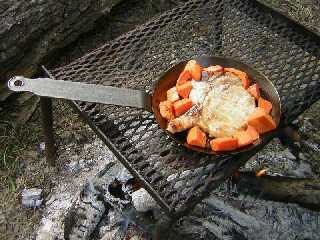 Here's the 7" x 3/4" crepe pan in action over my front yard campfire. It's cooking a center cut pork chop and a handful of Schwans Roasted Sweet Potatoes #774.
Here's the 7" x 3/4" crepe pan in action over my front yard campfire. It's cooking a center cut pork chop and a handful of Schwans Roasted Sweet Potatoes #774. I seasoned the pork chop and the potatoes only with a good sprinkle of artificial brown sugar. No salt, no pepper, just some artificial brown sugar because that's what I had on hand. The taste? I kept saying as I ate, "Man, this is good! Oh, my goodness, this is good!" The great thing about this crepe pan for campfire cooking is the slanted sides. You don't have to turn it nearly vertical to pour out excess grease like with most skillets. Turn it a little, and out pours the grease while the food stays put. However, the trait which makes these crepe pans so good for campfire cooking makes them awful for stovetop cooking. Grease splatters over the low and slanted sides and gets all over the stovetop. Use them for pancakes on the stovetop and for anything on a campfire.
|
 = hated it
= hated it  = didn't like it
= didn't like it = liked it
= liked it = really liked it
= really liked it = loved it
= loved it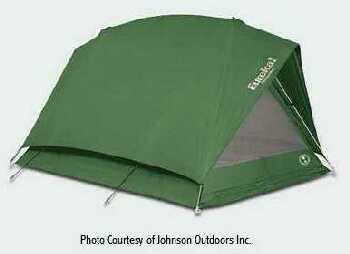 Here we see a Timberline 4 in a staged factory photo. Don't expect yours to look so perfect.
Here we see a Timberline 4 in a staged factory photo. Don't expect yours to look so perfect.